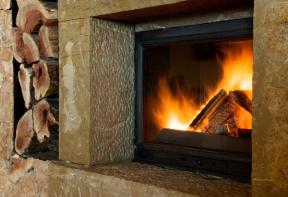Installing a gas fireplace
Cozy up your home with a clean and efficient gas fireplace
It’s hard to give up an old wood fireplace. The smell, the crackle, the fun of poking at the fire-they all make a home feel more inviting. But then there are the downsides. Traditional fireplaces are not very efficient heat sources. Cleaning up ashes, cutting and bringing in wood, and worrying about fire hazards are other reasons many homeowners look for alternatives, such as fireplace inserts.
Think of a fireplace insert as a closed box-really a kind of stove-that fits inside an existing fireplace. There are wood-burning inserts, which maintain some of the wood-fire romance but add efficiency, while pellet fuel inserts burn what looks like oversized rabbit droppings consisting of wastewood and other biomass. Electrical inserts, simple to install, are more for aesthetics than efficient heat. But the most popular type, especially in homes that already use gas for heating and cooking, are gas-burning inserts.
In this installation, in a city home built in the 1920s, a zero-clearance gas insert was the homeowner’s clear choice. The existing fireplace hadn’t been used in years and would have required a lot of work to make it safe for a wood fire. Wood was more expensive, and more trouble, than the homeowner wanted.
Because each installation is different, needing an experienced eye and a licensed gas fitter, putting in a gas fireplace insert is not really a do-it-yourself project, even though our expert, Wes Willard of Miles Industries, made it look easy. But you can do a lot of the prep work on your own. Before this insert could go in, for example, the fireplace surround needed some cosmetic surgery. The original brick had been clumsily repaired and coated with what looked like leftover cake icing. A simple drywall surround is an easy do-it-yourself solution that complements the sleek, modern renovation that’s in progress in the rest of the house. If future owners decide to redecorate, they’ll have a ready framework for a more traditional mantel and surround.
Is it Efficient?
No and yes. No, if energy efficiency is your only priority. In that case, first upgrade or at least tune up your home furnace, then block off the fireplace, never to be used again.
But if you want to use your fireplace, especially as a zone heater, a gas insert makes sense. You’ll save energy if you use the smaller gas insert instead of firing up the main furnace, particularly in spring and fall.
Choosing a fireplace will depend on your budget and your tastes. You’ll find just about any style, from Italian Renaissance to Victorian to High Modernism-even Southwest kiva fireplaces that will look perfect in your pueblo. But if you want your fireplace for supplementary heating, look for substance as well as style-a fireplace that’s labelled as “heater-rated” is more efficient than one that is described as “decorative.” Manufacturers and testing agencies assume a heater-rated fireplace insert will be turned on much longer, so these inserts are built and tested to higher standards than decorative models.
Lower energy bills
According to Canada Mortgage and Housing Corporation, these are some of the features of the most energy-efficient gas fireplaces:
– a high Annual Fireplace Efficiency(AFE) rating
– direct venting
– an intermittent electronic ignition system, a pilot light that’s easy to turn off and relight, or a two-stage pilot
– a radiation-transparent ceramic glass front
– a quiet “squirrel cage”-type circulating fan
– a secondary heat exchanger
– insulated outer casing
– the ability to turn the heat down
Jump to a section
- Page 1 : Lower your energy bills
- Page 2 : Finding the right size, matching your vents
- Page 3 : Glossary of heating terms
To leave a comment, please log in












No comments